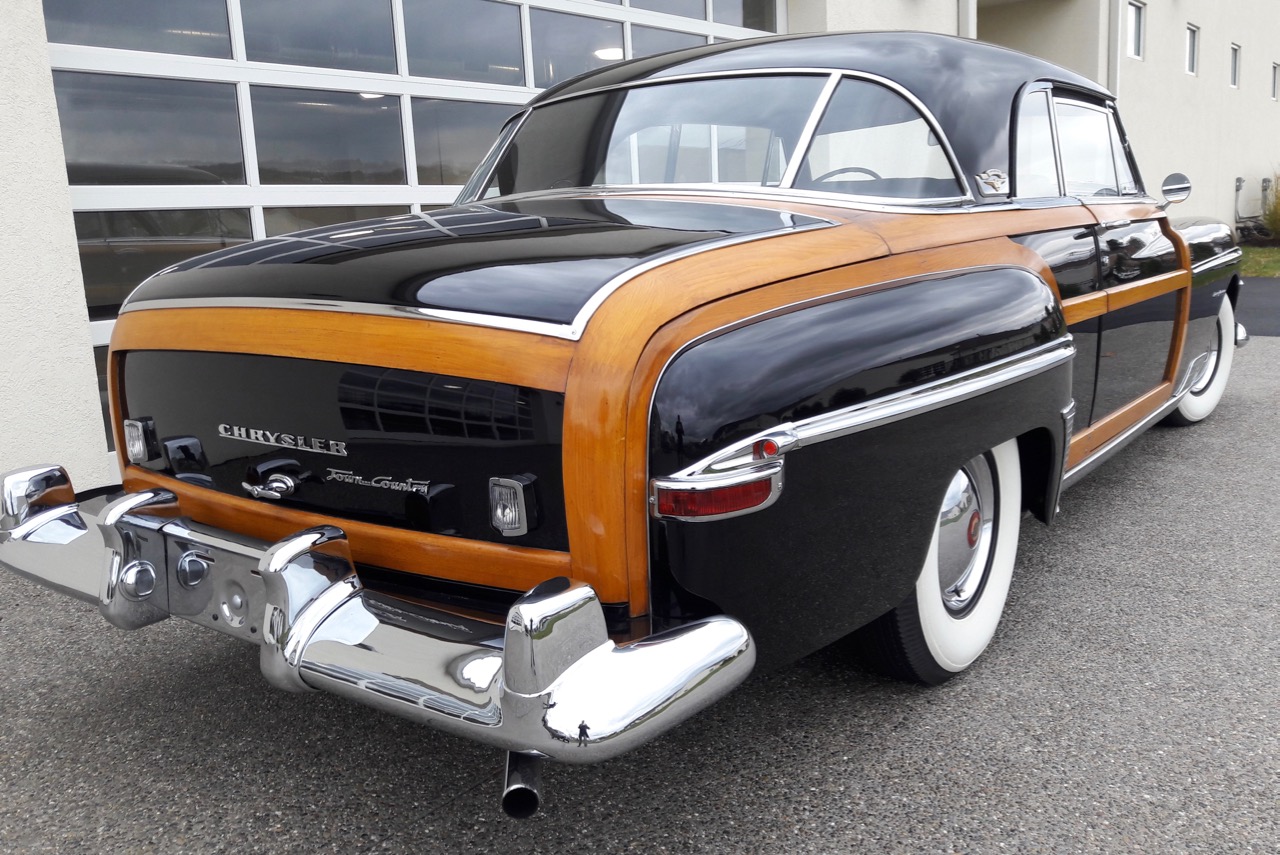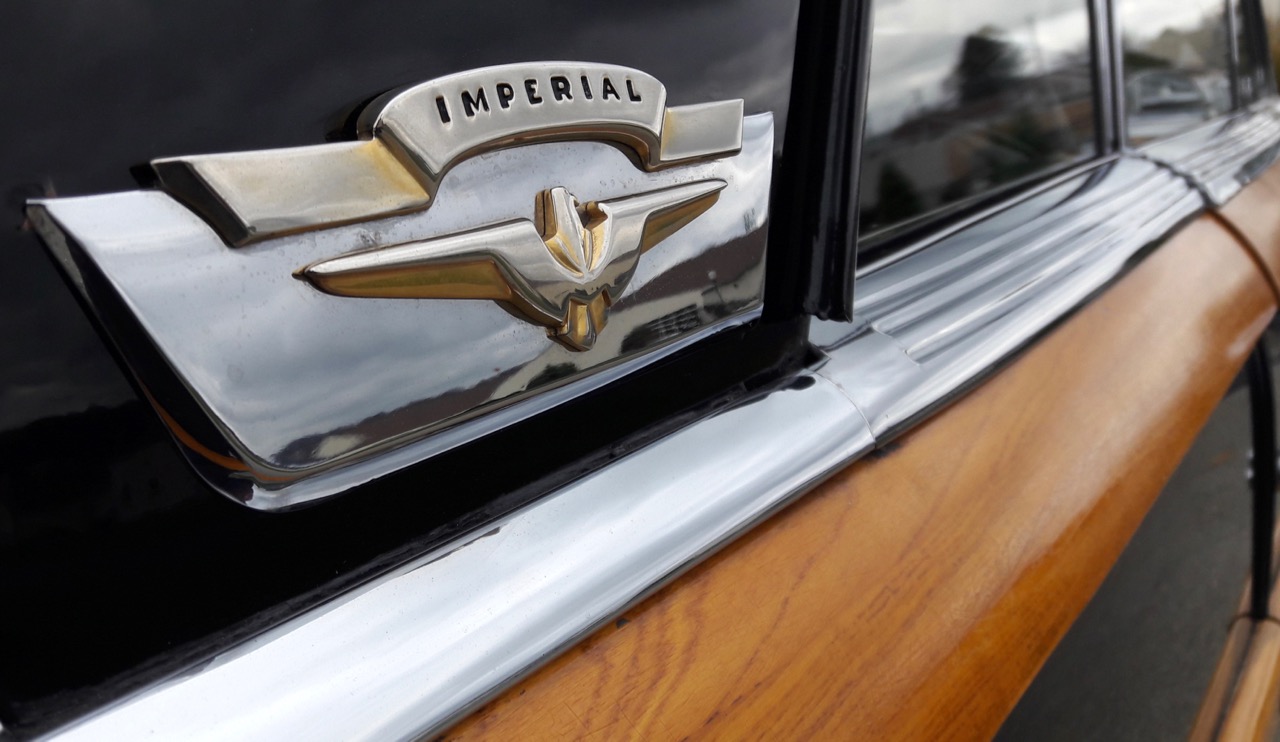
The 1950 Town & Country Newport coupe was the swan song for Chrysler’s wonderful wood-sided luxury cars. As some of the most expensive models in Chrysler’s lineup, these “woodies” were often the car of choice for celebrities and movie stars.
Yet, even the brightest name on the biggest marquee eventually fades away. By the time 1950 rolled around, the Town & Country’s time in the spotlight was drawing to a close. Ironically, despite being in its last year, Chrysler opted to roll out an entirely new variant.

Less than 700 examples of the Town & Country Newport were produced in the model’s final year of production. This was the first, and the last, wood-bodied hardtop coupe that Chrysler would build.
As you can see, the body of the car combined steel panels with an overlay of white ash. Long before Chrysler tainted the reputation of its wood-paneled masterpieces with newer versions sporting tacky decals and plastic-wood (here’s looking at you K-cars), the last true Town & Country is a glorious combination of old-world craftsmanship and Art Deco design.
The ash frames had to be hand-formed to each model, a process that took lots of time and incredible skill. This laborious process also explains the $4,000-plus price-tag this car wore when it was brand new on a dealership lot.
Speaking of dealerships, this particular example has led a very sheltered life, courtesy of the Indiana-based Chrysler dealer who ordered it from the factory. Not only has it covered only 4,100 miles over its 67-year lifespan, the car has \never been titled. The Chrysler still has its Dealer MSO (Manufacturers Statement of Origin) and sports many other unique details that set it apart.
Unlike the majority of Town & Country Newport coupes, this model is fitted with a black top, not the usual white one. There are also Imperial logos affixed to each C-pillar, a feature not seen on any other example.

This must have been a one-off custom order, according to the staff at the NB Center in Allentown, Pennsylvania, where this Chrysler now resides. Since joining the Bulgari collection in 2010, this car has remained without a title, to keep the unique provenance intact.
That doesn’t mean this stately machine leads an idle life. Sliding onto the wide black-and-white front bench seat, you feel as though you’ve walked into the lobby of the Chrysler building in New York City. Art Deco design touches are everywhere, from the incredibly over-engineered look of the dashboard and gauges, to subtle fluting on the hand cranks for the windows. Jet age designs were coming up quickly circa 1950, but this car harkens back to a previous era that didn’t include towering tail fins or flashy tri-color paint jobs.
It sure does have chrome, that’s for sure! The front and rear bumpers are massive, and streaks of chrome flow along each side of this imposing Chrysler. And honestly, do white-wall tires get any whiter, or more charming, than the ones found on this Town & Country? Taking exterior photos of the Chrysler proved an exercise in trying to hide my reflection in the copious amount of shiny metal that covers so much of the exterior.
On the private test track at the NB Center, the Chrysler’s refined driving manners are a match for its regal bearing. The car wafts along, riding on a 127.5-inch wheelbase as we twirl the giant steering wheel while navigating the course.
Unlike several others cars we’ve driven on the track, there were no tire squealing antics performed in the Town & Country. While we don’t doubt the 135-horsepower, 323.5 cubic inch inline-8 and Fluid Drive transmission can get the job done with plenty of gusto, it simply didn’t seem fitting to drive like a hooligan in such a classy automobile.

Mastering the Fluid Drive gearbox does take a little practice. You can sum up this transmission as being a half-step between a manual and full automatic. The clutch pedal is primarily used to get the car rolling from a dead stop. The peculiar thing is you don’t have to feather it much at all, the process is much more of a ‘step on’ and ‘step off’ affair. You feel like you’re being rough on the car, but it works every like a charm every time.
Once rolling, you can ignore the clutch pedal and swap through gears using the column mounted shifter. There are some noticeable “thunks” when changing gears, though we were assured the noises were absolutely normal for this quirky transmission.
The Chrysler Town & Country Newport feels like it should be pulling into a country club, or a posh movie premiere with a starlet perched on the passenger seat. Steeped in style and class – not to mention that hand-crafted ash wood – this is a classic car that knows how to make an entrance.













beautiful car–have virtually identical black over black one in garage along with a brown version also.
This is the second series of Town and Country hardtops though. They were introduced in 1946 and only 6 or so built though. One still exists and was originally owned by David Wallace who was president of Chrysler Corporation and conceived the idea of the T&C. It spent most of it’s early life on his ranch near Burwell Nebraska and was in Hinckley Ohio when we first saw it in the early 70’s.
It was shown in the 46 sales literature and in 49 a hardtop was also listed in the sales literature and I have seen photos of the one that was apparently made then also.
Your description of using/not using the shift lever is a bit confusing. I have a 48 New Yorker in my garage, although not driven by me for many years, I remember it was possible not to use the shifter at all after coming to a stop. It shifted down to second gear, and you just added throttle to take off(albeit slowly) then when the throttle was let up it shifted into 3rd. Your description of: “once rolling,…swap through the gears using the column shifter”, was unnecessary, for if the shifter was in the 2nd or 3rd gear position, it would shift gears by letting up on the throttle, hence using the column shifter was not needed! I don’t think the Fluid Drive would have changed in 2 years.
Both of you are partially right. The Chrysler fluid drive was a 4 speed transmission. It had a clutch and torque converter. For normal driving you would depress the clutch and place the shift lever in drive position, down. Release the clutch and press the accelerator . The car would be in 3rd gear, accelerate to the desired speed on 20 – 25mph, and relaese the accelerator . You would hear a mild “clunk”. The trans would be shifting to 4th gear, and you cruised along. When you wanted to come to a stop you would press the brake pedal. No need to press the clutch pedal. When the car came to a stop you would hear a mild clunk, the trans would be downshifting to 3rd gear. When you released the brake pedal, accelerate and the cycle would repeat.
For rapid starts or hill climbing you would press the clutch and move the shift lever up to low (1st & 2nd gear). You would accelerate to 10 – 15 mph and release the accelerator, you would hear the mild clunk, the trans would be shifting from 1st to 2nd gear. You could accelerate to 45 – 50 mph, the trans would remain in 2nd gear. At this point you would depress the clutch pedal and pull the shift lever down to high position, you would be in 3rd gear, accelerate to 50 +, release the accelerator pedal, hear the mild clunk, you would be in 4th gear.
It sounds complicated, but it was quite simple. In a day or two of driving most drivers had mastered the art. Horace Noble 84.